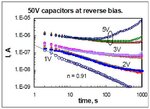danny davis
Banned

They are electrolytic capacitors, they get put in backwards by accident
When One of the electrolytic capacitors is backwards, it pulls down the VCC voltage, why is that?
The VCC's are either 12 volts or 5 volts
If there is a electrolytic capacitor put in backwards by accident it will pull the VCC down lower
I just don't know why it pulls down the voltage when a polarized capacitor is put in backwards
When a Polarized capacitor is reversed in a circuit it acts like a short or open? or how does it operate when its put in reverse polarity or backwards polarity?
What is this called? is this "reverse biasing" the electrolytic or polarized capacitor?
When One of the electrolytic capacitors is backwards, it pulls down the VCC voltage, why is that?
The VCC's are either 12 volts or 5 volts
If there is a electrolytic capacitor put in backwards by accident it will pull the VCC down lower
I just don't know why it pulls down the voltage when a polarized capacitor is put in backwards
When a Polarized capacitor is reversed in a circuit it acts like a short or open? or how does it operate when its put in reverse polarity or backwards polarity?
What is this called? is this "reverse biasing" the electrolytic or polarized capacitor?



